Common names from other countries
Environment: milieu / climate zone / depth range / distribution range
экология
морской; пределы глубины 0 - 100 m (Ref. 106604). Tropical; 41°N - 40°S, 80°W - 29°W
Western Atlantic: New Jersey, USA (Ref. 7251) to Santos, Brazil (Ref. 26340) and Argentina (Ref. 58839). Eastern Atlantic: St. Paul's Rocks (Ref. 13121).
Size / Вес / Возраст
Maturity: Lm ? range ? - ? cm
Max length : 230 cm WD самец/пол неопределен; (Ref. 126011); наибольший вес (опубликованные данные): 115.9 kg (Ref. 126011)
Cephalic fins smaller, tail longer without spine (Ref. 7251). Upper surface black (Ref. 6902).
Occurs in shallow coastal waters (Ref. 12951). Feeds mainly on planktonic crustaceans but may take small schooling fishes (Ref. 12951). Ovoviviparous (Ref. 50449). Found singly, in small groups, and in schools (Ref. 12951). Swimming at high speed and often leap high above the surface (Ref. 6902). Feeds mainly on planktonic crustaceans, but also on small schooling fishes (Ref. 114953). Meat used for food and a source of oil (Ref. 6902).
Life cycle and mating behavior
Maturities | размножение | Spawnings | Egg(s) | Fecundities | личинки
Exhibit ovoviparity (aplacental viviparity), with embryos feeding initially on yolk, then receiving additional nourishment from the mother by indirect absorption of uterine fluid enriched with mucus, fat or protein through specialised structures (Ref. 50449). Copulation has been observed to be in a venter to venter position while the pair swims at the surface. Mating reported to last 10 minutes. Litter number 1 (Ref. 12951).
Robins, C.R. and G.C. Ray, 1986. A field guide to Atlantic coast fishes of North America. Houghton Mifflin Company, Boston, U.S.A. 354 p. (Ref. 7251)
Статус Красного Списка МСОП (Ref. 130435)
Угроза для людей
Harmless
Использование человеком
рыболовство: не имеет хозяйственного значения
дополнительная информация
инструменты
Специальные отчеты
Скачать в формате XML
ресурсы в Интернет
Estimates based on models
Preferred temperature (Ref.
115969): 13.7 - 27.7, mean 23.2 (based on 232 cells).
Phylogenetic diversity index (Ref.
82804): PD
50 = 0.5005 [Uniqueness, from 0.5 = low to 2.0 = high].
Bayesian length-weight: a=0.01000 (0.00244 - 0.04107), b=3.04 (2.81 - 3.27), in cm Total Length, based on all LWR estimates for this body shape (Ref.
93245).
Trophic level (Ref.
69278): 3.8 ±0.59 se; based on food items.
устойчивость к внешним воздействиям (Ref.
120179): очень низкий, минимальное время удвоения популяции более 14 лет (Fec=1).
Fishing Vulnerability (Ref.
59153): Very high vulnerability (85 of 100).
